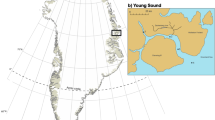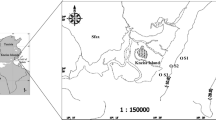Abstract
Population dynamics of four dominant Antarctic copepods, Calanoides acutus, Calanus propinquus, Metridia gerlachei and Rhincalanus gigas were studied based on zooplankton samples collected in the Prydz Bay during austral summer from 1999 to 2006. We found that C. acutus was the most abundant species among these four copepods, followed by C. propinquus, M. gerlachei and R. gigas. R. gigas occurred mainly in the warmer oceanic regions and showed distribution patterns discrete from the other three species, whose distribution in the whole survey area overlapped. By December 15th (about one month before our sampling) of the years 1999, 2003 and 2006, sea ice retreated earlier and polynyas existed in the neritic region one month before sampling. These periods were characterized by numerical dominance of C. acutus, C. propinquus and M. gerlachei, elevated proportions of Copepodite I and Copepodite II stages especially in the neritic region. While for the years 2000, 2002, and 2005, the ice edge located more northerly and polynyas did not exist in the neritic region, the copepods abundance was lower, indicating poor recruitment. Population structure of R. gigas was mainly composed of advanced stages Copepodite V and female during all cruises. Log10 (x+1) transformed densities of C. acutus, C. propinquus and M. gerlachei showed positive correlation with temperature and chlorophyll a concentration, while mean population stages of these copopods were negatively correlated with these environmental variables. Younger copepodite stages of C. acutus, C. propinquus and M. gerlachei appeared more often in neritic regions. We confirmed that the polynyas had a great contribution to phytoplankton blooms, which promote copepods reproduction and recruitment success. The study suggested that population dynamics of the four copepods have good correspondence with sea ice and polynya variations during all cruises of the Prydz Bay.
Similar content being viewed by others
References
Arrigo K R, DiTullio G R, Dunbar R B, Robinson D H, Van Woert M, Worthen D L, Lizotte M P. 2000. Phytoplankton taxonomic variability in nutrient utilization and primary production in the Ross Sea. J. Geophys. Res., 105: 8 827–8 846.
Atkinson A. 1998. Life cycle strategies of epipelagic copepods in the Southern ocean. J. Marine Syst., 15: 289–311.
Atkinson A. 1991. Life cycles of Calanoides acutus, Calanus simillimus and Rhincalanus gigas (Copepoda: Calanoida) within the Scotia Sea. Mar. Biol., 109: 79–91.
Bathmann U V, Makarov R R, Spiridonov V A, Rohardt G. 1993. Winter distribution and overwintering strategies of the Antarctic copepod species Calanoides acutus, Rhincalanus gigas and Calanus propinquus (Crustacea, Calanoida) in the Weddell Sea. Polar Biol., 13: 333–346.
Beaumont K L, Hosie G W. 1997. Mesoscale distribution and abundance of four pelagic copepod species in Prydz Bay. Antarct. Sci., 9(2): 121–133.
Burghart S E, Hopkins T L, Vargo G A, Torres J J. 1999. Effects of a rapidly receding ice edge on the abundance, age structure and feeding of three dominant calanoid copepods in the Weddell Sea, Antarctic. Polar Biol., 22: 279–288.
Carli A, Pane L, Stocchino C. 1999. Planktonic copepods in Terra Nova Bay (Ross Sea): distribution and relationship with environmental factors. In: Faranda F M, Guglielmo L, Ianora A eds. Ross Sea Ecology, Berlin, Germany: Springer. p.309–322.
Catalano G, Povero P, Fabiano M, Benedetti F, Goffart A. 1997. Nutrient utilisation and particulate organic matter changes during summer in the upper mixed layer (Ross Sea Antarctica). Deep Sea Res., 44: 97–112.
Chiba S, Ishimaru T, Hosie G W, Fukuchi M. 2001. Spatio-temporal variability of zooplankton community structure off east Antarctica (90° to 160°E). Mar. Ecol. Prog. Ser., 216: 95–108.
Chiba S, Ishimaru T, Hosie G W, Fukuchi M. 2002. Spatio-temporal variability in life cycle strategy of four pelagic Antarctic copepods: Rhincalanus gigas, Calanoides acutus, Calanus propinquus and Metridia gerlachei. Polar Biosci., 15: 27–44.
Conover R J, Huntley M. 1991. Copepods in ice-covered seas-distribution, adaptations to seasonal limited food, metabolism, growth patterns and life cycle strategies in polar seas. J. Mar. Syst., 2: 1–40.
Errhif A, Razouls C, Mayzaud P. 1997. Composition and community structure of pelagic copepods in the Indian sector of the Antarctic Ocean during the end of the austral summer. Polar Biol., 17: 418–430.
Field J G, Clarke K R, Warwick R M. 1982. A practical strategy for analysing multispecies distribution patterns. Mar. Ecol. Prog. Ser., 8: 37–52.
Graeve M, Hagen W, Kattner G. 1994. Herbivorous or omnivorous? On the significance of lipid compositions as trophic markers in Antarctic copepods. Deep Sea Res. PT I., 41: 915–924.
Hopkins T L. 1987. Midwater food web in McMurdo Sound, Ross Sea, Antarctica. Mar. Biol., 96: 93–106.
Hopkins T L, Torres J J. 1988. The zooplankton community in the vicinity of the ice edge, Western Weddell Sea, March 1986. Polar Biol., 9: 79–87.
Hosie G W, Cochran T G. 1994. Mesoscale distribution patterns of macrozooplankton communities in Prydz Bay, Antarctica-January to February 1991. Mar. Ecol. Prog. Ser., 106: 21–39.
Hosie G W, Schultz M B, Kitchener J A, Cochran T G, Richards K. 2000. Macrozooplankton community structure off east Antarctica (80°–150°E) during the austral summer of 1995/1996. Deep Sea Res., PT II, 47: 2 437–2 464.
Hunt B P V, Pakhomov E A, Trotsenko B G. 2007. The macrozooplankton of the Cosmonaut Sea, east Antarctica (30°E–60°E), 1987–1990. Deep Sea Res., PT I, 54: 1 042–1 069.
Huntley M, Escritor F. 1992. Ecology of Metridia gerlachei Giesbrecht in the western Bransfield Strait, Antarctica. Deep Sea Res., 39: 1 027–1 055.
Lancelot C, Mathot S, Veth C, Baar H. 1993. Factors controlling phytoplankton ice-edge blooms in the marginal ice-zone of the northwestern Weddell Sea during sea ice retreat 1988: field observations and mathematical modeling. Polar Biol., 13: 377–387.
Lizotte M P. 2003. Microbiology of sea ice. In: Thomas D N, Dieckmann G S eds. Sea Ice: An Introduction to Its Physics, Chemistry, Biology and Geology. Blackwell Science, Oxford. p.184–210.
Marin V. 1988. Qualitative models of the life cycles of Calanoides acutus, Calanus propinquus, and Rhincalanus gigas. Polar Biol., 8: 439–446.
Michels J, Schnack-Schiel S B. 2005. Feeding in dominant Antarctic copepods—Does the morphology of the mandibular gnathobases relate to diet? Mar. Biol., 146: 483–495.
Pakhomov E A, Froneman P W. 2004. Zooplankton dynamics in the eastern Atlantic sector of the Southern Ocean during the austral summer 1997/1998—Part 2: Grazing impact. Deep Sea Res., PT II, 51: 2 617–2 631.
Pane L, Feletti M, Francomacaro B, Mariottin G L. 2004. Summer coastal zooplankton biomass and copepod community structure near the Italian Terra Nova Base (Terra Nova Bay, Ross Sea, Antarctica). J. Plankton Res., 26(12): 1 479–1 488.
Pasternak A, Hagen W, Kattner G, Michels J, Graeve M, Schnack-Schiel S B. 2009. Lipid dynamics and feeding of dominant Antarctic calanoid copepods in the eastern Weddell Sea in December. Polar Biol., 32: 1 597–1 606.
Pasternak A F, Schnack-Schiel S B. 2001. Feeding patterns of dominant Antarctic copepods: an interplay of diapause, selectivity, and availability of food. Hydrobiologia, 453/454: 25–36.
Schnack-Schiel S B. 2001. Aspects of the study of the life cycles of Antarctic copepods. Hydrobiologia, 453/454: 9–24.
Schnack-Schiel S B, Haas C, Michels J, Mizdalski E, Schunemann H, Steffens M, Thomas D N. 2008. Copepods in sea ice of the western Weddell Sea during austral spring 2004. Deep Sea Res., PT II, 55: 1 056–1 067.
Schnack-Schiel S B, Hagen W. 1994. Life cycle strategies and seasonal variations in distribution and population structure of four dominant calanoid copepod species in the eastern Weddell Sea, Antarctica. J Plankton Res., 16(11): 1 543–1 566.
Tanimura A, Kawaguchi S, Oka N, Nishikawa J, Toczko S, Takahashi K T, Terazaki M, Odate T, Fukuchi M, Hosie G. 2008. Abundance and grazing impacts of krill, salps and copepods along the 140°E meridian in the Southern Ocean during summer. Antarctic Sci., 20(4): 365–379.
Voronina N M. 2003. The effect of sea ice on the life cycles of mass species of Antarctic copepods in the Weddell Sea. Oceanology, 43(6): 832–839.
Ward P, Shreeve R S, Cripps G C, Trathan P N. 1996. Mesoscale distribution and population dynamics of Rhincalanus gigas and Calanus simillimus in the Antarctic Polar Open Ocean and Polar Frontal Zone during summer. Mar. Ecol. Prog. Ser., 140: 21–32.
Ward P, Whitehouse M, Shreeve R, Thorpe S, Atkinson A, Korb R, Pond D, Young E. 2007. Plankton community structure south and west of South Georgia (Southern Ocean): Links with production and physical forcing. Deep Sea Res., PT I, 54(11): 1 871–1 889.
Zhang G T, Sun S. 2002. Fecundity and population structure of dominant copepod species in Prydz Bay (Antarctica) in summer. Oceanologia et Limnologia Sinica, 33(2): 196–202. (in Chinese with English abstract)
Zwally H J, Parkinson C L, Comiso J C. 1983. Variability of Antarctic sea ice and changes in carbon dioxide. Science, 220: 1 005–1 012.
Author information
Authors and Affiliations
Corresponding author
Additional information
Supported by National Key Technology Research and Development Program of China (No. 2006BAB18B07), the National Natural Science Foundation of China (No. 40821004), National Polar Project of China (No. JDZX20110016), and the China International Polar Year (IPY) Program
Rights and permissions
About this article
Cite this article
Yang, G., Li, C. & Sun, S. Population dynamics of four dominant copepods in Prydz Bay, Antarctica, during austral summer from 1999 to 2006. Chin. J. Ocean. Limnol. 29, 1065–1074 (2011). https://doi.org/10.1007/s00343-011-0230-4
Received:
Accepted:
Published:
Issue Date:
DOI: https://doi.org/10.1007/s00343-011-0230-4




